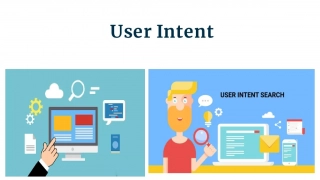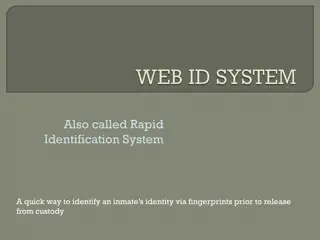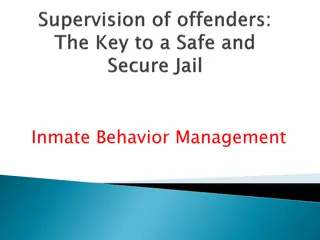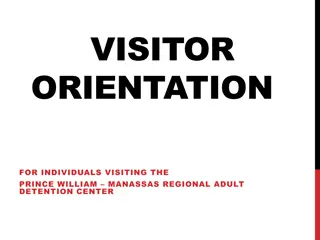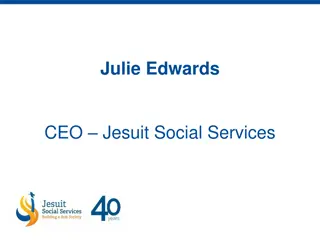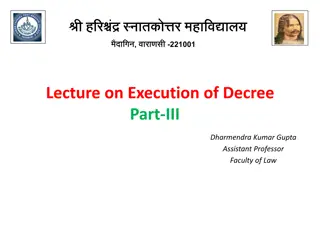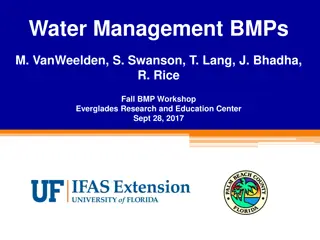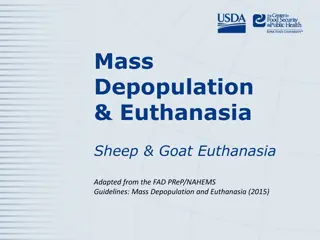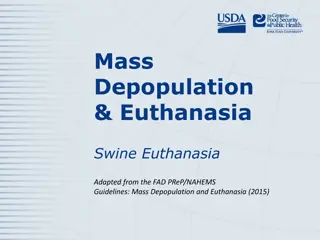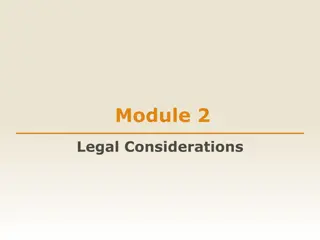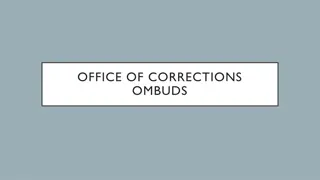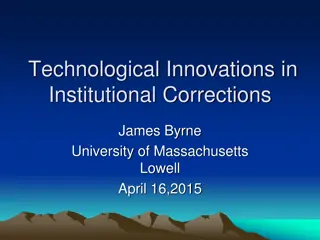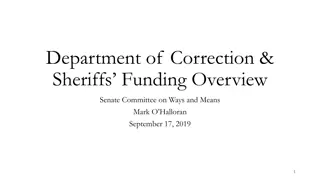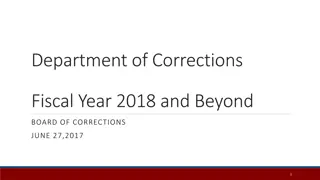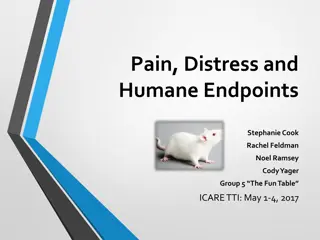Strategic Intent for Safe and Humane Inmate Detention
This strategic planning session focuses on ensuring safe, secure, and humane detention of inmates through comprehensive case management systems, partnership maintenance, overcrowding strategies, and technological advancements. The goal is to improve service delivery methods and stakeholder collaboration for better inmate outcomes.
Download Presentation

Please find below an Image/Link to download the presentation.
The content on the website is provided AS IS for your information and personal use only. It may not be sold, licensed, or shared on other websites without obtaining consent from the author. Download presentation by click this link. If you encounter any issues during the download, it is possible that the publisher has removed the file from their server.
E N D
Presentation Transcript
2019 Strategic Planning Session 15 August 2019 INCARCERATION (Remand Detention and Offender Management) 1
Presentation outline Summary of the strategic intent of the 2018 Strategic Planning Session Current service delivery method (SDM) Contextual issues considered in the planning Environmental analysis Historical performance Five Year Plan (2020-2025) Secondary Outputs (AOP) Resource considerations Critical success factors and dependencies Strategic risks 2
Summary of the 2018 Strategic Planning Session 5 Year Strategic Intent Impact: Outcome: Safe, secure and humane detention of inmates Strategic intent Comprehensive case management system *Review and benchmark best practices *Improved case management through automation of business processes. *Integrated planning and collaboration with stakeholders *Review and implement overcrowding strategy *Monitoring and evaluation
Summary of the 2018 Strategic Planning Session 10 Year Strategic Intent Impact: Outcome: Safe, secure and humane detention of inmates Strategic intent Comprehensive case management system *Secure, credible and reliable information. *Maintain partnerships with relevant stakeholders *Identify and explore technological advancements for implementation *Evaluate the effectiveness of overcrowding strategy
Summary of the 2018 Strategic Planning Session 50 Year Strategic Intent Impact: Outcome: Safe, secure and humane detention of inmates Strategic intent Comprehensive case management system *Implement and monitor policies and the Strategy for the Management of overcrowding *Strengthen partnerships with relevant stakeholders to improve/broaden the reach of services and interventions; *Participate in Integrated Planning with stakeholders; *Implementation of advanced technology in collaboration with JCPS and SAPS
Current service delivery method What are the core services How are these delivered (service delivery arrangements) Weaknesses with the current arrangements Interventions required/alternative modes Admission, detention, placement or release of inmates Assessment, classification and profiling to determine needs based interventions that guides rehabilitation through the Correctional Sentence Plan Qualifying offenders are considered by CSPB for placement on day parole, parole, medical parole and correctional supervision Manual case management system A&R system is outdated Lack of integrated criminal justice information and management system (SAP62, SAP 69C & sentence remarks) CMC, Parole Board & NCCS) Inefficient case management processes Inconsistencies in decision making by CSPBs Review Case Management systems, processes and tools Inmate management Induction, training & re- training of new and old CSPB members on policy and procedure Implementation of the multi pronged strategy Lack of integrated planning within the Cluster Inadequate implementation of the multi pronged strategy Review of the current Multi pronged Strategy. Management of overcrowding of inmates Improved collaboration with JCPS Cluster partners 6
Environmental analysis Political Although safety is a high priority, attention is more likely to be given to other CJS in the criminal justice sector as DCS is at the end of the value chain and also dealing with perpetrators as there is growing call for focus on victims to a large extent Economic Unemployment remains stubbornly high especially amongst the youth, which may lead to high crime levels which impact negatively on the offender population. Current economic pressures may impact negatively on service delivery. Prevalence of economic crimes (crimes of greed) and corruption may result in more arrests and incarceration Social Inequalities in societies result in poverty, unemployment, illiteracy, lack of support systems that can lead to violence and criminality leading to increased inmate population. Changing nature of criminal trends, increase in violent and serious crimes and types of offenders including minimum sentencing legislation will have an ongoing negative impact on inmate population and overcrowding (Crimes of need). Technological Availability of advanced technology leads to different type of crimes but also enables offenders to commit crimes from within Correctional Centres. Resource constraints in keeping up to date and abreast of the 4th industrial revolution. 8
Environmental analysis Environmental Impact of global warming resulting in changing weather patterns. Energy and water crisis while having negative challenges has also led the Department to explore in investing in alternative energy source to reduce electricity costs. Legal Offenders are more aware of their legal rights which has an increasing impact on the department in terms of litigations. Communication Impact of social media on facilitating criminal activities and use of advance communication technology such as bluetooth enabled smart phones e.g. bullying. Public perception of DCS as well as public awareness and education on services rendered by the DCS. 9
Inmate Population and Bedspace: 1994/1995 to 2018/2019 Inmate Population: 1994/1995 to 2018/2019 185501 162861 161819 160583 160280 159331 158681 157141 119134 119134 119134 118723 118572 115827 114149 111192 99486 92790 Avg: 1994/1995 Avg: 1999/2000 Avg: 2004/2005 Avg: 2009/2010 Avg: 2014/2015 Avg: 2015/2016 Avg: 2016/2017 Avg: 2017/2018 Avg: 2018/2019 Bedspaces Unsentenced Sentenced All inmates Linear (Bedspaces) 10
Historical performance What has been achieved in the past 5 years and what has worked well What have we failed to achieve in the past 5 years and why What need to be done differently / change Development and implementation of the White Paper on Remand Detention White Paper on Remand Detention not embedded in the Correctional Services Act Review Correctional Services Act to incorporate aspects of the White Paper on Remand Detention Development & implementation of CJS protocols for the Management of Remand Detainees Determination of the effectiveness of the protocols Review of protocols and conduct integrated M&E CSPBs have exceeded the set target in considering cases that have served to them by the CMCs Parole Board contracts not renewed within time Review the current model of the parole system Expedite the appointment of all parole board members Average number of sentenced offenders remain stable at below 120 000 Significantly reduce the inmate population Integrated approach in the management of overcrowding with Cluster Departments Children in detention reduced by more than 30% (46.7%) 11
5 Year Strategic Plan - Results Chain Impact (Impact Statement) Outcome (5 year target) Primary Outputs (KPI S) Risk assessment of inmates Quality profiles considered timeously by CSPBs Safe, secure and humane detention of inmates Comprehensive case management system Integrated and automated case management system and information 5 year target: 100% inmates subjected to case management processes (admission, detention, placement and release.) Inmate Management Management of overcrowding 12
Action Plan on outputs Primary Outputs (KPI S) Secondary Output Activities Timeframes Responsibility Risk assessment of inmates Conduct assessment and keep a record of inmates subjected to risk assessment. Daily Area Commissioner Number of inmates subjected to continuous Risk Assessment Quality profiles considered timeously by CSPBs Number of profiles of offenders considered by CSPB on or before reaching their minimum detention period and further profile dates. Implementation and compliance with source documents. Monthly Chairperson CSPB Keep records of profile reports received and considered by the CSPB. Consistent participation and timeous submission of SAPS . 20
Action Plan on outputs Primary Outputs (KPI S) Secondary Output Activities Timeframes Responsibility Integrated and automated case management system and information Availability of an effective automated system Development October 2019 CDC Incarceration and Corrections / Remand Detainees dependency CDC GITO, Phased rollout March 2023 Availability of business information tool Training of officials on case management system March 2020 Capturing of data manually and electronically October 2019 Management of overcrowding Reduced inmate population Implement multi pronged strategy January 2020 CDC Incarceration and Corrections Review of the multi pronged strategy December 2019 CDC Incarceration and Remand Detention Participate in Social and Economic Clusters activities to comprehensively address overcrowding CDC Incarceration and Remand Detention Regional Commissioners As scheduled 14
Action Plan on outputs Primary Output Secondary Output Activities Timeframes Responsibility Inmate Management Effective inmate management within the correctional centres Review CMC and CSPB processes 31 December 2019 CDC Incarceration and Corrections / Remand Detention Implement CMC and CSPB processes Area Commissioners Provision of all relevant A&R reports to assists within offender and cluster management As required/requested CDC Incarceration and Corrections / Remand Detention/GITO Implement Integrated Inmate Management System (IIMS) 31 December 2019 CDC Incarceration and Corrections / Remand Detention Review and implementation of the decision making tool for CMCs and CSPBs 31 December 2019 CDC Incarceration and Corrections / Remand Detention 15
Resource considerations In view of the proposed budget cuts Branches to think how they will use this opportunity to influence change, how do we optimise existing resources and extract optimal value. Inputs already been provided for a proposed new transitional structure for the Programme Incarceration and has been adopted into the interim structure. Inputs has been provided for legislation review on (49G) Policy review of the uniform package of the inmates An improved collaboration with other departments will be advantageous for the Programme Incarceration due to dependencies on other external stakeholders Special Remission: A proposal in this regard has been put on route for consideration by Cabinet for granting of a special remission to sentenced offenders, including probationers and parolees Consideration of placement of remand detainees who have bail of R1000 and less under non-custodial alternatives (per capita incarceration cost approximately R400.00 p.d) 18
Critical success factors and dependencies Critical success factors Dependencies Amendment of legislation and approval of new and reviewed policies and procedures Cooperation of relevant internal and external stakeholders (SAPS, NPA, DoJ, Legal Aid South Africa, oversight authorities, DoH) Reduced levels of overcrowding Cluster partners in the CJS to effectively contribute towards the reduction in overcrowding levels. Finalization and implementation of the DCS revised organizational structure Implementation of service delivery model Redefine business processes and service delivery tools Availability of an effective automated system Implementation of IIMS and Integrated Justice System 19
Strategic Risks Outcome Primary Outputs (KPIs) Risk Probability (High/ Medium/ Low) Impact (High/ Medium/ Low) Mitigation Strategy Comprehensive case management system Risk assessment of inmates Lack of safety and security for inmates, officials and public High High Implementation of the results of risk assessment Quality profiles considered timeously by CSPBs Erroneous releases High High Implementation of IIMs (e.g. scheduling) Wrong placements Induction, training and retraining of CMC and CSPB members Inmates representations, litigations and riots Integrated and automated case management system and information Decision making affected negatively. High High Implementation of IIMs Unreliable and delayed information 20
Strategic Risks Outcome Primary Outputs (KPI S) Risk Probability (High/ Medium/ Low) Impact (High/ Medium/ Low) Mitigation Strategy Effective and efficient case managemen t Inmate management Incorrect inmate classification and re-classification High High Automated business processes Litigations Corrupt practices Management of overcrowding Negative impact on resources (e.g.HR, infrastructure, bulk services) High High Integrated cluster management of overcrowding Spread of infections Non-separation of vulnerable from hardened criminals 21
Highly Confidential Thank You THANK YOU STRIVING FOR A SOUTH AFRICA IN WHICH PEOPLE ARE AND FEEL SAFE 22


